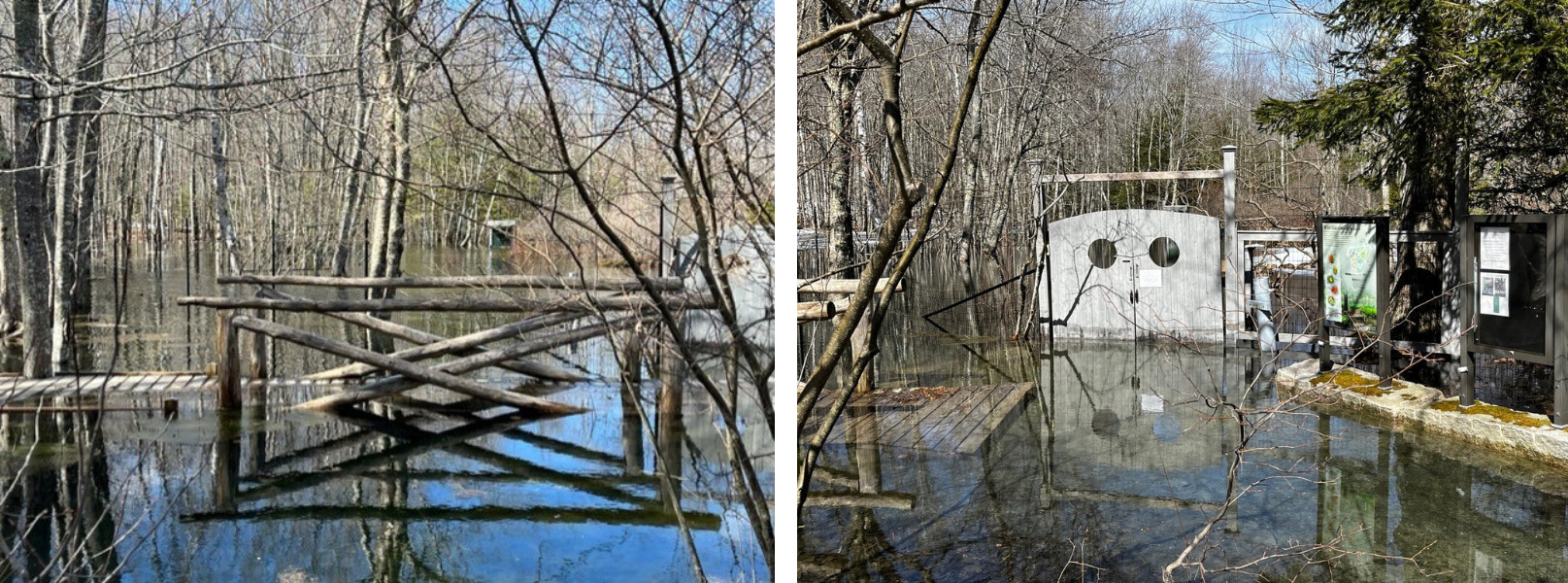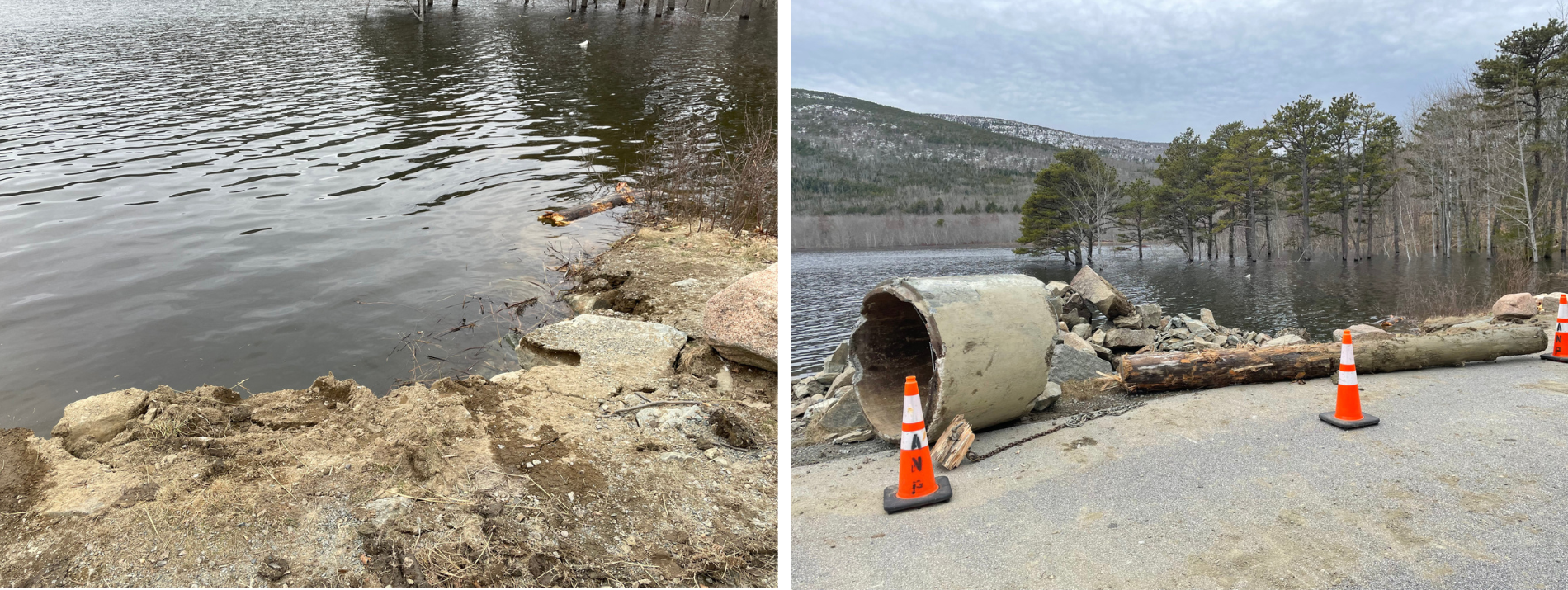Flooding at Great Meadow Wetland Reinforces Need for Climate-Smart Restoration
As of April 5, clogged culvert has been partially cleared and water is moving.
April 5th, 2023
As of April 5, clogged culvert has been partially cleared and water is moving.
April 5th, 2023

Recent flooding at the Wild Gardens of Acadia. (Photo courtesy Cora Olgyay)
If you’ve visited the Sieur de Monts area of Acadia this week—or if you’ve been on social media and seen the dramatic photos with people kayaking the Jesup Path—you likely know of the extensive flooding that’s occurring in the Great Meadow Wetland and the Wild Gardens areas of the park. Currently, the flooding extends well into the Sieur de Monts parking lot, which remains closed.
What’s going on?
The extensive flooding in the Great Meadow Wetland was caused by blockage of the undersized culvert downstream at the Park Loop Road. The culvert is unable to accommodate large rainfall (or rain-on-snow) events that are becoming more common as a result of climate change.
While beavers are active in the Great Meadow and have constructed several dams between the culvert and the Wild Gardens, their activity is not likely impacting the current flooding. In fact, this flood submerged beaver dams and lodges in the wetland, at least temporarily displacing beaver during this flood.
The combination of an undersized culvert prone to blockage and large rainfalls has caused significant flooding this winter. The park closed the Sieur de Monts parking lot January 30 because of flooding and, in the past several weeks, park staff have tried several times to unblock the culvert.

Photos of the recent flooding. (Courtesy photos)
Just today, April 5, crews were able to partially clear the culvert and water is moving again. But it is expected to take a while for the water level to return to normal.
Of course, Acadia National Park staff and all of us at Friends of Acadia are very concerned about the impacts of flooding on the Sieur de Monts area.
That’s why Friends of Acadia has partnered with the National Park Service and Schoodic Institute to develop a comprehensive, climate-smart restoration plan to address it.
Why does this keep happening?
Climate change is accelerating alterations to weather patterns and seasonality that have direct impacts on Acadia’s infrastructure, cultural resources, the occurrence and distribution of plants and animals, and the timing of natural phenomena.
Acadia’s average annual precipitation has increased by roughly six inches and the park is experiencing more intense rainstorms. This recent flooding at Sieur de Monts is the latest example.
The Great Meadow Wetland—while beautiful—doesn’t have the function or diversity of a healthy wetland. Alterations such as road construction and ditching have altered the flow of water through the meadow and into Cromwell Harbor.
During large rain events, water levels can quickly overwhelm the undersized culvert at the outlet of the wetland, causing flooding, which has become much more frequent in recent years. The small size of the culvert and blockages of it can prevent floods from receding quickly.
In addition to causing flooding problems, the altered flow has caused the plant species to shift toward fewer overall species and to species that can tolerate disturbed conditions, that includes some that are invasive, such as glossy buckthorn.
What’s being done to address it?
The National Park Service, with its partners Friends of Acadia and the Schoodic Institute, is working to address flooding and other impacts of past activities, while also striving to create wetland conditions well adapted to our changed climate and anticipated further changes.
The park is replacing the undersized culvert in 2024 with a wider stream-smart crossing designed to accommodate larger rainfalls and to improve the ability of wildlife to pass between the Great Meadow and the rest of Cromwell Brook.
Friends of Acadia added funding to further supplement the project to address additional legacy impacts, such as plugging ditches, removing an abandoned roadbed, and restoring streambanks.
Federal funding through the Bipartisan Infrastructure law provides even greater capacity to improve recreational experiences and restore the health of the Great Meadow wetland through invasive species removal, native plant restoration, and trail improvements to reconnect the natural water flow in the wetland.
The Great Meadow Wetland Restoration Plan
The park service held a public scoping meeting in November, 2022, inviting public input on its plan to restore the Great Meadow Wetland.
The proposed project plan includes replacing the culvert at the outflow of the Great Meadow, restoration of Cromwell Brook, removal of non-native invasive plant species with native plant restoration, targeted wetland restoration, and visitor-use improvements to increase accessibility and enjoyment of the area. Since that public meeting, the National Park Service began developing an environmental assessment, which will be released for public comment this spring.
As of now, we don’t know what, if any, damage the flooding has caused to the Wild Gardens or Great Meadow. Many of the plants and animals in Great Meadow are adapted to spring flooding events. After water levels return to normal, the park and partner staff will assess the damage and plot a path forward together.
In other news:
Great Meadow floods … again | Environment | mdislander.com
Read more about Acadia’s Great Meadow Restoration work and how climate change is impacting Acadia:
More than meets the eye at Great Meadow
Great Meadow Wetland – Acadia National Park
Climate-smart Restoration in Great Meadow – via Wetland News

Rocks and logs recently pulled out of the old and undersized culvert, which help to catch and clog the culvert with material that naturally flows out of a wetland, such as sedges, branches, and logs.
This vulnerability is one of the big reasons for replacing the culvert with a wider stream-smart crossing.
(Photo courtesy Rebecca Cole-Will)

(Photos courtesy Rebecca Cole-Will)
The rapid pace of environmental change since industrialization is threatening what we love most about Acadia.